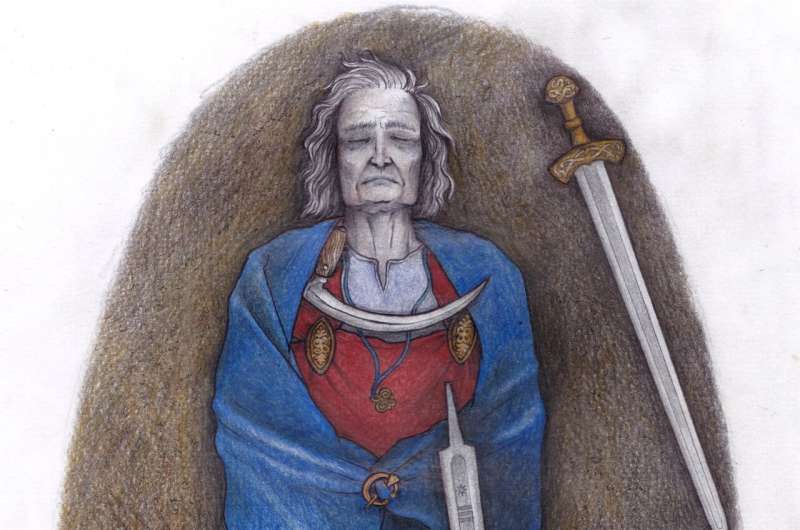Anthropology
Related: About this forum1,000-year-old remains in Finland may be non-binary iron age leader
Related: A Woman with a Sword? – Weapon Grave at Suontaka Vesitorninmäki, Finland (Cambridge University Press)
Also: Weapon grave of Suontaka, Hattula in Finland reveals flexible gender roles in the early Middle Ages (University of Turku)
______________________________________________________________________
Source: The Guardian
1,000-year-old remains in Finland may be non-binary iron age leader
DNA suggests body buried in feminine attire with swords had Klinefelter syndrome, researchers say
Jon Henley
@jonhenley
Mon 9 Aug 2021 14.23 BST
Modern analysis of a 1,000-year-old grave in Finland challenges long-held beliefs about gender roles in ancient societies, and may suggest non-binary people were not only accepted but respected members of their communities, researchers have said.
According to a peer-reviewed study in the European Journal of Archaeology, DNA analysis of remains in a late iron age grave at Suontaka Vesitorninmäki in Hattula, southern Finland, may have belonged to a high-status non-binary person.
First discovered in 1968 during building work, the grave contained jewellery in the form of oval brooches as well as fragments of woollen clothing suggesting the dead person was dressed in “a typical feminine costume of the era”, the researchers said.
But unusually, the grave also held a hiltless sword placed on the person’s left side, with another sword, probably deposited at a later date, buried above the original grave – accoutrements more often associated with masculinity.
-snip-
Read more: https://www.theguardian.com/world/2021/aug/09/1000-year-old-remains-in-finland-may-be-non-binary-viking-researchers-say

______________________________________________________________________
Source: University of Turku
JULY 29, 2021
Weapon grave of Suontaka, Hattula in Finland reveals flexible gender roles in the early Middle Ages
by University of Turku
The modern re-analysis of a weapon grave found in Suontaka, Hattula in Finland over 50 years ago challenges the traditional beliefs about gender roles in the Iron Age and Early Medieval communities and reveals information about the gender expressions of the period. The grave also functions as a proof of how non-binary people could have been valued and respected members of their communities.
In 1968, a sword with a bronze handle was found at Suontaka Vesitorninmäki, Hattula, Finland during a digging project for a water pipe. The sword lead to the discovery of a grave that was almost a thousand years old, and the grave has since become rather well-known for the objects it contained.
The jewelry inside the grave indicates that the buried individual was dressed in typical female clothing of the period. On the other hand, the person was buried with a sword—possibly two, according to some interpretations—which is often associated with masculinity. Over the decades, the Suontaka grave has been considered to be either a double burial of both a woman and a man, or alternatively, a weapon grave of a female, and therefore a proof of strong female leaders or even female warriors in the Late Iron Age Finland. However, a newly-published study challenges both views.
The study confirmed that only one person had been buried in the grave, and that the person was wearing typical feminine clothes of the period and had a hiltless sword placed on their left hip.
"The buried individual seems to have been a highly respected member of their community. They had been laid in the grave on a soft feather blanket with valuable furs and objects," says Doctoral Candidate of Archaeology Ulla Moilanen from the University of Turku.
-snip-
Read more: https://phys.org/news/2021-07-weapon-grave-suontaka-hattula-finland.html
FM123
(10,126 posts)Martin68
(24,604 posts)pansypoo53219
(21,724 posts)mahatmakanejeeves
(60,940 posts)Mysterious 1,000-year-old remains may be of a nonbinary person, researchers say
By Caroline Anders
Today at 6:30 a.m. EDT
In the grave lay a bronze-hilted sword, another long blade missing its hilt, a sheathed knife, three brooches, a sickle and pieces of a skeleton, nearly decomposed.
The collection of items lying with the bones seemed to evade traditional Western notions of gender. The swords suggested that the person they were buried alongside might be a man, but the jewelry indicated that the body belonged to a woman. This person, dated to 1050-1300 A.D., seemed important; they were buried wearing what may have been costly animal pelts and arranged on what once was bedding that contained feathers.
Much remains unknown about them. Researchers don’t know whether they were a leader or warrior, what their life looked like or how they would have identified.
But, according to a recent study from Finnish and German researchers, they were a male-bodied person of some wealth or importance buried in traditionally feminine dress. And that raises questions about the fluidity of gender in early medieval Finland. Researchers say it’s possible that this person was nonbinary — not strictly male or female.
{snip}
By Caroline Anders
Caroline Anders is a reporting intern on the General Assignment desk. Twitter https://twitter.com/caroIineanders